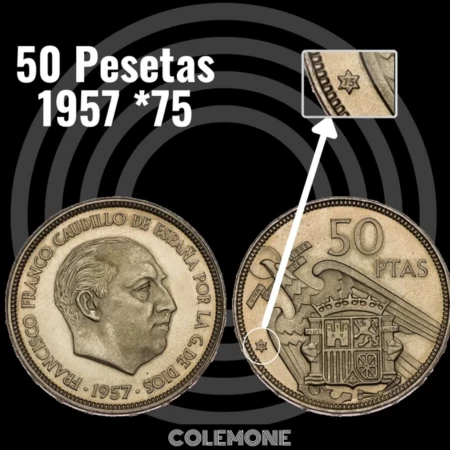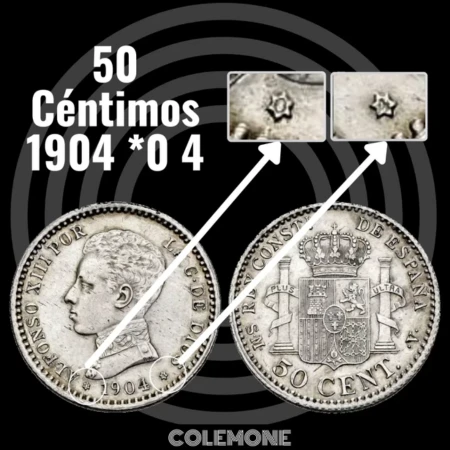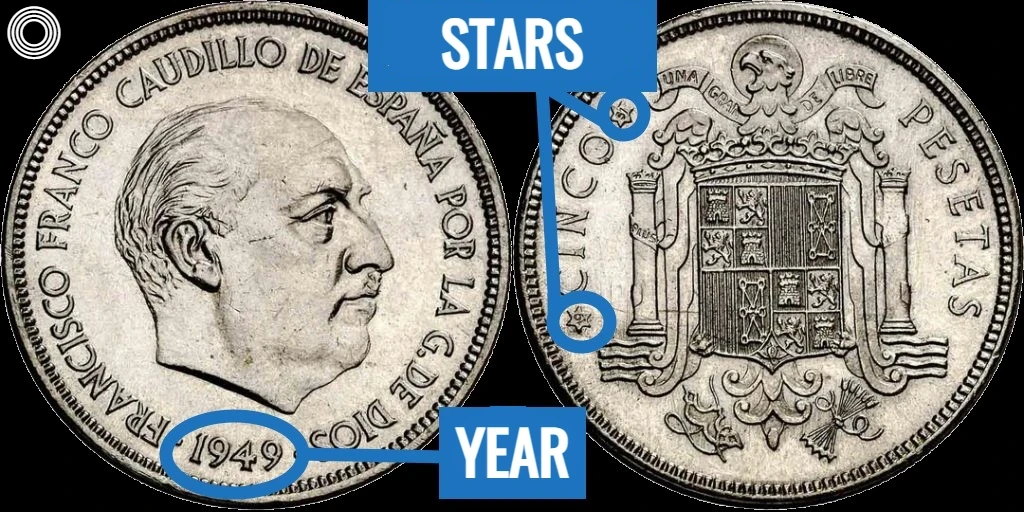Here at ColeMone, once in a while, we dedicate a post to explain basic concepts in numismatics. In this article, we will take a look at one of the most fundamental things in Spanish numismatics: what the numbers on the little stars on Spanish coins mean.
Additionally, we will explore how these stars can be counterfeited and how to detect them, what happens when there is no number inside them, and whether stars exist in other countries.
Let’s start with the meaning:
In Spanish peseta coins issued between 1868 and 1982, the numbers inside the six-pointed stars represent the year the coin was minted, while the large year indicates the year that the law governing the issuance of that particular coin was passed.
The star is usually indicated in written texts with an asterisk preceding the number inside it. For example, if we write “50 pesetas 1957 *75“, it means that the year in the large font on the coin, the year of the passing of the law, is 1957, and inside the star, there will be a number 75, indicating that the coin was minted in 1975.
Now, let’s move on to the examples:
Examples of stars in peseta coins
Keep in mind that the star will always have six points. That’s because it’s the identifying symbol of the Madrid Mint. Before the introduction of the number and star system, when coins were minted in other places, there were also coins with stars of a different number of points.
For example, a 4-pointed star identified the Jubia Mint in Ferrol (Galicia), a 5-pointed star represented the Manila Mint (Philippines), a 7-pointed star denoted the Seville Mint, and an 8-pointed star indicated the Barcelona Mint.

But out of all of them, only the 6-pointed star, the one from Madrid, had numbers inside it. Let’s see some examples of all the types of stars with numbers that can exist.
One star, one number
This type is usually found exclusively on small copper coins of Alfonso XIII. For example, in the 1906 1-cent coin, there is a ‘6’ inside the star.

One star, two numbers
Since we mentioned the 1957 50 pesetas at the star of this article, I’ll use it again as an example in which there is only one star, but it has two numbers:

Two stars, one number in each
This type is not very common. It can be found in some coins from the Second Republic and especially in some coins of Alfonso XIII, such as the 50 centimos from 1904.

Two stars, two numbers in each
The 50 centimos coin from 1949 is a perfect example of two stars with two numbers in each:

Counterfeit stars
Sometimes, the numbers inside the stars make a significant difference in the value of a coin, ranging from a just few dollars to several thousands. One of the most striking cases can be found in the 5 pesetas coin from 1949: with the numbers 19 and 50 inside the stars, it is worth 3 dollars, but with the numbers 19 and 52, it is worth around 18,000 dollars.

Given such a discrepancy, some people have taken to manipulating the stars to try and pass off one coin as another.
The two most common manipulation techniques are:
- Filing: The star is filed down until the number disappears, and a new number is engraved with a very small burin.
- Modification: The strokes of the number in the star are manipulated to change one digit into another. For example, a stroke is added to the 6 to turn it into an 8.
Sometimes, it is not easy to distinguish when a star has been manipulated, as it often requires direct visual comparison with another coin. In most cases, a good magnifying glass or even a microscope is required.
In the case of filing, the manipulated star will have less height than the other star. Additionally, the stroke of the numbers will almost always be different from the one made at the mint.
Regarding modification, the star will have the same height, but the stroke of the number will appear somewhat strange and irregular, once again being different from the one made at the mint.
Not everyone has a trained eye for this, as it requires having seen many coins. So, in case of doubt regarding a high-value coin, it is better to take it to a numismatic shop or an auction house.
What if there are no numbers inside the stars?
Not all coins from that period have stars.
And sometimes, even if there are stars, no numbers appear inside them. This can be due to two reasons, and to determine which one exactly, the condition of the coin must be examined.
Reason 1: Clearly circulated coin
When a coin that has clear signs of having been in circulation does not have numbers inside the stars, it is most likely that it did have them originally but they have worn off with use.
In that case, the coin (generally) has lost almost all its numismatic value.
Reason 2: Coin with very little or no wear
If the coin is completely new or nearly new, then it is very likely that there was a minting error and the numbers inside the stars were never struck on the coin, a phenomenon called “anepigraphic stars.”

If this is the case with your coin, its value will depend on the piece itself, and it would need to be assessed on a case-by-case basis. However, it may be worth slightly more than the value it would have if the same coin had stars with numbers.
Have star numbers ever been used outside of Spain?
Yes.
In 1969, the Spanish National Mint minted coins for the Equatorial Guinea peseta, shortly after the independence of that country (hence the specific mention of the Spanish peseta in the title of this article). And in those Equatorial Guinea peseta coins, there were stars with numbers, with the same meaning as in the Spanish pesetas.

But that is the only exception outside of Spain.